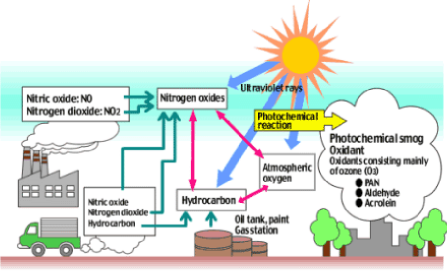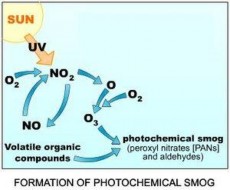11. Smog
It refers to a mixture of smoke and fog. It also results from sun’s effect on certain pollutants in the air, notably those from automobile exhaust. There are two main types of smog— photochemical and industrial.
The photochemical smog is a mixture of primary and secondary pollutants. The primary pollutants are hydrocarbons and nitrogen oxides and their main source is the motor vehicles. The secondary pollutants are formed when sunlight acts upon motor vehicle exhaust gases to form harmful substances such as ozone (O3), aldehydes and peroxyacetylnitrate (PAN). Photochemical smog formation requires (1)a still, sunny day and (2)temperature inversion (pollutants accumulate in the lower inversion layer). The photochemical smog directly affect lungs and eyes, causing irritation in these organs.


The industrial smog is a mixture of sulphur dioxide and a variety of solid and liquid particles suspended in air.It comes from the stationary sources, such as furnaces, power plants, etc., than from motor vehicles. Sulphur dioxide in combination with water and oxygen can turn into

13. Atmospheric Brown Cloud (ABC)/Asian Brown Cloud
The ABC originally referred to the enormous blanket of pollution spreading across Asia, distorting normal weather patterns in the region and threatening to devastate many countries’ economies. It was called the ‘Asian Brown Cloud’ in 2002, when a UN report first warned of this layer of pollution comprising ash, acids and aerosols. At that time, the two-mile thick haze extended ominously across the most densely populated areas of the world: southern, south- eastern, and eastern Asia. Subsequently, however, similar patterns were detected elsewhere in the world and it was renamed ‘Atmospheric Brown Cloud’.
Asia is particularly vulnerable as the ABC causes changes in the winter monsoon season, sharply reducing rain over northwestern parts of the continent and increasing rain along the eastern coast. However, India's scientific community have said the atmospheric brown clouds over Asia are a seasonal, temporary phenomena which may look bad, but have none of the catastrophic implications mentioned in the UN report.
12. Haze
is traditionally an atmospheric phenomenon where dust, smoke and other dry particles obscure the clarity of the sky. The World Meteorological Organization manual of codes includes a classification of horizontal obscuration into categories of fog, ice fog, steam fog, mist, haze, smoke, volcanic ash, dust, sand and snow. Sources for haze particles include farming (ploughing in dry weather), traffic, industry, and wildfires. One way to distinguish between smog and naturally-occurring haze is by color. Natural haze is typically white, gray or even blue. Smog is almost always yellowish or brown in color.
The international definition of fog is a visibility of less than 1 kilometre; mist is a visibility of between 1 kilometre and 2 kilometres and haze from 2 kilometres to 5 kilometres . Fog and mist are generally assumed to be composed principally of water droplets, haze and smoke can be of smaller particle size.
sulphuric acid in the atmosphere and falls on the earth as acid rain. It can dissolve marble and eat away iron and steel. In human it can affect the respiratory system.
Name: | Industrial smog (New York smog, gray smog) | Photochemical smog (Los Angeles smog, Denver smog, brown smog) |
Weather: | cool, damp | sunny |
Content: | particulates, sulfur oxides | NOx, ozone, hydrocarbons, PAN |
Sources: | coal, etc. | gasoline(Petrol), combustion. |
